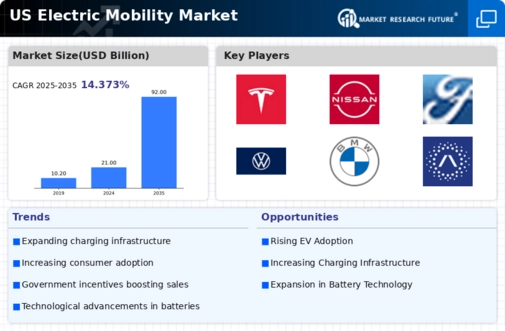Expansion of Renewable Energy Sources
The electric mobility market is closely linked to the expansion of renewable energy sources in the US. As the energy grid increasingly incorporates solar, wind, and other renewable sources, the environmental benefits of electric vehicles become more pronounced. This synergy is likely to enhance the appeal of EVs, as consumers recognize that charging their vehicles with clean energy reduces overall emissions. Recent data suggests that renewable energy accounted for approximately 20% of total electricity generation in the US, a figure that is expected to rise. This trend not only supports the electric mobility market but also aligns with broader national goals for energy independence and sustainability. The integration of renewable energy into the charging infrastructure is anticipated to further accelerate the adoption of electric vehicles.
Enhanced Government Regulations on Emissions
The electric mobility market is being influenced by enhanced government regulations aimed at reducing vehicle emissions. Stricter emissions standards are prompting automakers to invest in electric vehicle technology to comply with new regulations. The US government has set ambitious targets for reducing greenhouse gas emissions, which are likely to drive the adoption of electric vehicles. Recent legislation indicates that by 2030, the federal government aims to have 50% of all new vehicle sales be electric. This regulatory environment is expected to create a favorable landscape for the electric mobility market, as manufacturers respond to compliance requirements by expanding their electric vehicle offerings. The interplay between regulation and market dynamics is likely to shape the future of transportation in the US.
Corporate Fleets Transitioning to Electric Vehicles
The electric mobility market is witnessing a significant transition as corporate fleets increasingly adopt electric vehicles. Many companies are recognizing the potential cost savings associated with EVs, including lower fuel and maintenance expenses. Additionally, corporations are motivated by sustainability goals and the desire to enhance their public image. Reports indicate that over 30% of large companies in the US are planning to electrify their fleets within the next five years. This shift not only contributes to the growth of the electric mobility market but also encourages the development of supportive infrastructure, such as dedicated charging stations. As more businesses commit to electric mobility, the market is likely to experience accelerated growth, driven by both economic and environmental considerations.
Technological Innovations in Electric Vehicle Design
Technological advancements are playing a pivotal role in shaping the electric mobility market. Innovations in vehicle design, such as improved aerodynamics and lightweight materials, are enhancing the efficiency and performance of electric vehicles. Furthermore, the integration of smart technologies, including advanced driver-assistance systems (ADAS) and connectivity features, is attracting tech-savvy consumers. The electric mobility market is also witnessing the development of more efficient electric drivetrains, which can significantly extend the range of EVs. According to industry reports, the average range of new electric vehicles has increased by over 30% in recent years, making them more appealing to a broader audience. These technological innovations are likely to bolster consumer confidence and stimulate further investment in the electric mobility market.
Rising Consumer Demand for Sustainable Transportation
The electric mobility market is experiencing a notable surge in consumer demand for sustainable transportation solutions. As environmental awareness increases, consumers are gravitating towards electric vehicles (EVs) as a means to reduce their carbon footprint. Recent surveys indicate that approximately 70% of potential car buyers in the US express a preference for EVs over traditional internal combustion engine vehicles. This shift in consumer behavior is likely to drive manufacturers to innovate and expand their electric mobility market offerings. Additionally, the growing availability of eco-friendly models across various price ranges is expected to further enhance market penetration. As consumers prioritize sustainability, the electric mobility market is poised for substantial growth, reflecting a broader trend towards environmentally responsible choices in transportation.
























Leave a Comment